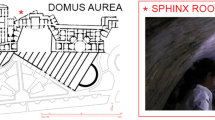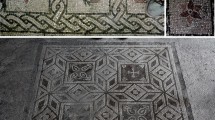Abstract
We report on a non-destructive study of Sicilian ceramic fragments of cultural heritage interest, classified as “proto-majolica” pottery and dating back to the twelfth to thirteen centuries AD. The analytical approach used is based on the employment of two totally non-invasive spectroscopic techniques: X-ray fluorescence (XRF), using a portable energy-dispersive XRF analyser, and X-ray absorption spectroscopy, using synchrotron radiation as a probe (SR-XAS). XRF measurements allowed us to collect elemental and spatially resolved information on major and minor constituents of the decorated coating of archaeological pottery fragments, so providing preliminary results on the main components characterizing the surface. In particular, we assigned to Fe and Mn the role of key elements of the colouring agent. With the aim of obtaining more detailed information, we performed SR-XAS measurements at the Fe and Mn K-edges at the Italian BM08 beamline at the European Synchrotron Radiation Facility (Grenoble, France). The experimental data were analysed by applying principal component analysis and least-squares fitting to the near-edge part of the spectra (X-ray absorption near-edge structure) to determine the samples’ speciation. From the overall results, umber, a class of brownish pigments characterized by a mixture of hydrated iron and manganese oxides, has been ascribed as a pigmenting agent.

Fe K-edge XANES spectra of selected proto-majolica samples and reference compounds (FeO, Fe3O4, Fe2O3, Fe+SiO2). D pigmented, L not pigmented.





Similar content being viewed by others
References
Aceto M, Agostino A, Boccaleri E, Cerutti Garlanda A (2008) XRay Spectrom 37:286–292
De Waal D (2009) J Raman Spectrosc 40:2162–2170
Appolonia L, Vaudan D, Chatel V, Aceto M, Mirti P (2009) Anal Bioanal Chem 395:2005–2013
Bacci M, Magrini D, Picollo M, Vervat M (2009) J Cult Herit 10:275–280
Hocquet FP, Garnir HP, Marchal A, Clar M, Oger C, Strivay D (2008) XRay Spectrom 37:304–308
Roldàn C, Murcia-Mascarós S, Ferrero J, Villaverde V, Lòpez E, Domingo I, Martínez R, Guillem PM (2010) XRay Spectrom 39:243–250
Parras-Guijarro D, Montejo-Gámez M, Ramos-Martos N, Sánchez A (2006) Spectrochim Acta A 64:1133–1141
Brostoff LB, Centeno SA, Ropret P, Bythrow P, Pottier F (2009) Anal Chem 81:6096–6106
Van der Snickt G, Janssens K, Schalm O, Aibéo C, Kloustc H, Alfelda M (2010) XRay Spectrom 39:103–111
Barilaro D, Barone G, Crupi V, Majolino D, Mazzoleni P, Tigano G, Venuti V (2008) Vib Spectrosc 48:269–275
Barilaro D, Crupi V, Majolino D, Venuti V, Barone G, Tigano G, Imberbi S, Kockelmann W (2008) J Phys Condens Matter 20:104254
Reher JJ, Albers RC (2000) Rev Mod Phys 72:621–654
Denecke MA (2006) Coord Chem Rev 250:730–754
Lau D, Kappen P, Strohschnieder M, Brack N, Pigram PJ (2008) Spectrochim Acta B 63:1283–1289
Tite MS, Freestone I, Mason R, Molera J, Vendrell-Saz M, Wood N (1998) Archaeometry 40:241–260
Padeletti G, Fermo P, Gilardoni S (2002) Mater Issues Art Archaeol VI 712:383–389
Ressler T, Wong J, Roos J, Smith IL (2000) Environ Sci Technol 34:950–958
Newville M (2001) J Synchrotron Rad 8:322–324
Meneghini C, Bardelli F (2009) Scientific software developed by C. Meneghini. http://webusers.fis.uniroma3.it/~meneghini/software.html
James F, Winkler M (2004) Minuit. http://www.cern.ch/minuit
Wilke M, Farges F, Petit PE, Brown GE Jr, Martin F (2001) Am Miner 86:714–730
Acknowledgements
The research was supported by Ministero dell’Università e della Ricerca Scientifica e Tecnologica grant MURST-PRIN2007. The authors are grateful to ESRF (Grenoble, France) for providing beam time and technical assistance.
Author information
Authors and Affiliations
Corresponding author
Additional information
Published in the special issue Analytical Chemistry for Cultural Heritage with Guest Editors Rocco Mazzeo, Silvia Prati, and Aldo Roda.
Rights and permissions
About this article
Cite this article
Bardelli, F., Barone, G., Crupi, V. et al. Combined non-destructive XRF and SR-XAS study of archaeological artefacts. Anal Bioanal Chem 399, 3147–3153 (2011). https://doi.org/10.1007/s00216-011-4718-8
Received:
Revised:
Accepted:
Published:
Issue Date:
DOI: https://doi.org/10.1007/s00216-011-4718-8




